Elevate your customer’s post-purchase experience and reduce support inquiries with seamless tracking integration.
As a Shopify merchant, I know you’re constantly looking for ways to enhance your customer’s post-purchase experience. One area that often gets overlooked, yet holds immense power, is order tracking.
It might seem like a minor detail, but providing clear, consistent, and easily accessible order tracking isn’t just a convenience; it’s a cornerstone of modern e-commerce success.
Today, I want to walk you through the ins and outs of order tracking integration for your Shopify store. We’ll cover why it’s crucial, what options are available, and how you can implement it effectively.
First, let’s consider why order tracking is so vital. From your customer’s perspective, once they’ve clicked “buy,” their primary concern shifts to “where is my order?”
Anxiety about delivery is real. Providing a simple way for them to check their order’s status alleviates this stress, building trust and reducing the need for them to contact your support team.
For you, the merchant, the benefits are equally compelling. Reduced “Where Is My Order?” (WISMO) inquiries mean your customer service team can focus on more complex issues, improving efficiency.
It also enhances brand perception. A professional, transparent tracking experience reflects positively on your business, encouraging repeat purchases and positive word-of-mouth.
Shopify, by default, offers some basic tracking capabilities. When you fulfill an order and add a tracking number, Shopify can link directly to the carrier’s website.
However, this native functionality often falls short for merchants looking for a truly branded and comprehensive solution. It requires customers to leave your site, and the experience isn’t unified.
This is where third-party order tracking integration solutions come into play. These apps and services are designed to elevate your tracking game significantly.
They act as a central hub, pulling tracking information from multiple carriers worldwide and presenting it in a consistent, user-friendly format, often directly on your Shopify store.
When considering a third-party solution, one of the first things to look for is multi-carrier support. Your customers might receive packages from various carriers, and you need a system that handles them all seamlessly.
Real-time updates are another non-negotiable feature. Customers expect to see their package’s journey unfold as it happens, from “order placed” to “out for delivery” and “delivered.”
A branded tracking page is a powerful tool. Instead of sending customers to a generic carrier site, imagine a tracking page that matches your store’s look and feel, reinforcing your brand identity.
Automated notifications are also key. These can be email or SMS updates triggered by specific events, like “shipped,” “in transit,” “out for delivery,” or “delivered.” They keep customers informed proactively.
Some advanced solutions even offer delivery exception alerts. If a package is delayed or encounters an issue, both you and your customer can be notified, allowing for proactive problem-solving.
Analytics and insights are invaluable. Understanding delivery performance, common delays, and carrier efficiency can help you optimize your shipping strategies and improve customer satisfaction over time.
Integration with your customer service tools, like a helpdesk or CRM, can further streamline operations. Support agents can quickly access tracking information without switching platforms.
So, how do you integrate these solutions? The process typically involves selecting an app from the Shopify App Store that aligns with your needs and budget.
Once installed, you’ll usually connect your shipping carriers within the app’s settings. Many apps automatically pull tracking numbers from your Shopify orders.
You’ll then configure your branded tracking page, customize notification templates, and set up any desired automation rules. Testing is crucial to ensure everything works as expected.
My advice is to communicate clearly with your customers about their tracking options. Include tracking links in your order confirmation emails and on your order status page.
Set realistic expectations regarding delivery times. While tracking provides transparency, it doesn’t speed up the actual shipping process.
Leverage the data you gather. If you notice a particular carrier consistently has delays in a certain region, it might be time to explore alternative options or adjust your shipping promises.
Proactive customer support, armed with detailed tracking information, can turn a potential complaint into a positive interaction, especially if a delivery issue arises.
Integrating robust order tracking isn’t just about preventing “WISMO” calls; it’s about building a superior post-purchase experience that fosters loyalty and encourages repeat business.
It transforms a potentially anxious waiting period into an engaging, transparent journey, reinforcing your brand’s commitment to customer satisfaction.
What are your thoughts on this article? Do you currently use a third-party tracking solution, or are you relying on Shopify’s native features? I’d love to hear your perspective.
Investing in a quality order tracking system is an investment in your customer relationships and, ultimately, in the long-term success of your Shopify store. It’s a small change with a big impact.






